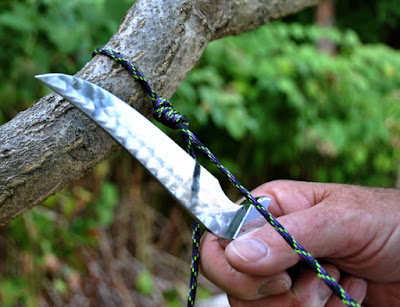The Western Reserve Cutlery
Association had Wayne Hensley custom make a sub-hilt fighter to celebrate their
40th anniversary.
 |
| Wayne never meant for us to carry this one, it didn't come with a sheath. |
I have to admit 40 years is a
funny anniversary. It’s a multiple of the
10th celebration, but it’s not 4 times more fun than the 10th
anniversary. Still, an anniversary is a
good reason to buy a custom knife.
I’ve always been interested in
sub-hilt fighters. The most noticeable
feature is the extra hilt or “trigger” as some people call it. I understand this design was developed by Bob
Loveless in his “Big Bear Classic.” I
suspect other people had previously devised this type of handle/hilt, but for
whatever reason it never took off. The
last really “new” thing I ever heard of was logarithms and that’s way off topic.
The upper edge of the Hensley
sub-hilt is semi-sharp. As I think of a
sub-hilt fighter, the upper edge should be razor sharp, making the knife more
of a dagger. For me that makes the knife
a little less useful as I often find myself pressing on the back edge to get
more force into the cutting stroke. Try
that with a dagger and you’ll get more get more cutting all right, but not
where you want it.
The Hensley sub-hilt blade is 4.5
inches of sharpened ATS34 steel and an ebony hard wood handle with bird head
butt. The stainless steel guard was to
be stamped/engraved/etched with series number.
WRCA had ordered 15 for their members, but through some mishap all the
knives got marked “1/15”. I guess that
is true enough, any one of these knives is one of the 15 made for the club.
We had requested a plaque or
shield in the side of the ebony handle, but somehow that too fell through the
cracks.
We’re also in the process of
selecting a club knife for 2017. These
are often, but not always folders. They
are, almost exclusively, boring “old man knives.” That of course is my opinion. Two and three bladed friction folders don’t
really ring my bell, but other club members love them. Frankly, I think it’s more of a cost
function.
I understand it. I remember when I could by a Spyderco for
half the current cost. What I also
remember is I used to buy gasoline for a half a buck and I was making $2.57 an
hour then. Scale the cost of that folder
you bought in 1953 by fuel cost and you’ll find modern knives are still a bargain.
WRCA is also getting ready to
launch the 2017 Knife Expo at the Knights of Columbus in Massillon, Ohio. The show will be May 20 and 21, 2017. I drove out there to see the building and
found it in the middle of a residential neighborhood. I was depending on my GPS to get out of
there, so I followed its instructions and after a couple of blocks it informed
me I was off roading. Well, I was making
such good time I didn’t want to stop.
Fortunately, I got to a major intersection, rebooted the darn thing and
it showed me the way to go home.
I wish we could find a nice
stable place to hold our show, but it doesn’t look like it will happen any time
soon.
At the last gun show in Medina
(that’s a local community not too far from me) I picked up an Arno Bernard
fixed blade with sheath. Arno Bernard is
from Bethlehem, South Africa, and he uses some rather interesting and exotic materials
for handles and sheaths.
 |
| It's a classy knife and it's never been used. |
This knife is one of his more plebeian issues. It’s from his Scavenger
series called the Wild Dog. It available
in several interesting handles, but mine is G-10. His website is a little apologetic about
using G-10 but as he claims, customers ask for it and it’s damn near
indestructible. The sheath is water
buffalo leather and very interesting.
 |
| I like the deep sheath which retains the knife in brush. There is more than one American manufacturer who could make deeper sheaths. |
He uses N690 steel which is
similar to VG-10, but with a bit more chromium and cobalt and a little less
vanadium. My research indicates N690 can
be hardened and tempered to 58-60 HRc.
Bernard started making knives in
1979 and it’s a family run operation with the kids and their wives
involved. I’m always impressed with how
one person can start something that grows to supports their family as well as
other families in their community.
I’m not going to keep this knife
and you’ll find it on my table next year.




















